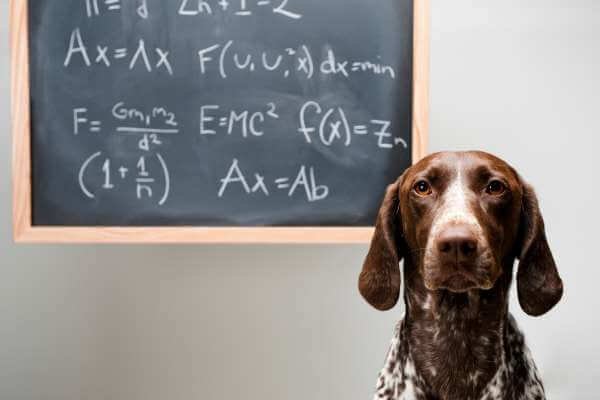As pet parents, we often find ourselves marveling at the intelligence of our furry friends. But how can you tell if your dog is smart? Dog intelligence can be measured in various ways, from learning new tricks to solving complex puzzles. Let’s explore some indicators that can help you assess the intelligence of your canine companion.
Understanding Dog Intelligence

Dog intelligence is typically categorized into three main types: adaptive intelligence, instinctive intelligence, and obedience intelligence.
- Adaptive Intelligence refers to a dog’s ability to solve problems on their own. This can be observed through their problem-solving skills and how quickly they learn from their environment.
- Instinctive Intelligence relates to the innate abilities that dogs possess. For example, herding dogs like the Border Collie have strong herding instincts.
- Obedience Intelligence measures how well dogs can learn from humans, including their ability to follow commands and learn new tricks.
Signs of a Smart Dog
- Learning New Tricks Quickly: If your dog picks up new commands with ease, this is a clear sign of high obedience intelligence. Smart dog breeds like the Border Collie, German Shepherd, and Labrador Retriever are known for their ability to learn new tricks rapidly.
- Solving Puzzle Toys: Providing your dog with puzzle toys is a great way to test their problem-solving skills. A dog that can figure out how to get a treat from a complex puzzle demonstrates strong adaptive intelligence.
- Observing Body Language and Facial Expressions: Smart dogs are highly attuned to human emotions and can understand body language and facial expressions. They often respond appropriately to social cues, showing empathy and understanding.
- Recognizing New Commands and Names: Dogs with high cognitive abilities can remember the names of different objects and follow complex commands. For example, a dog that can differentiate between various toys by name exhibits advanced language skills.
- Engaging in New Challenges: Intelligent dogs thrive on mental stimulation and enjoy facing new challenges. They are often eager to explore new places and learn new things.
- Problem-Solving Skills: Observing how your dog handles complex tasks, such as figuring out how to escape from a blanket or solving a puzzle, can provide insight into their cognitive abilities.
Testing Your Dog’s Intelligence
- Dog IQ Test: There are several dog IQ tests available that can help you assess your dog’s intelligence. These tests typically involve tasks like hiding treats under plastic cups and observing how quickly your dog finds them.
- Professional Evaluation: Consulting a professional dog trainer can provide a more accurate assessment of your dog’s intelligence. Trainers like Robert Cabral and experts from institutions like Eötvös Loránd University have extensive experience in evaluating canine intelligence.
Recognizing Intelligence in Different Breeds
While some dog breeds are renowned for their intelligence, it’s important to recognize that intelligence can manifest differently across breeds. The smartest dog breeds, according to experts like Stanley Coren, include the Border Collie, Poodle, German Shepherd, and Labrador Retriever. However, even breeds not typically listed among the most intelligent, such as the Australian Cattle Dog, can display remarkable problem-solving abilities and social intelligence.
Can I do brain training with my dog?
Absolutely, you can do brain training with your dog! Brain training is an excellent way to keep your dog’s mind sharp and improve their cognitive abilities. Here are some tips and methods to help you get started with brain training for your furry friend:
Benefits of Brain Training for Dogs
- Improves Problem-Solving Skills: Engages your dog’s brain and helps them think critically.
- Reduces Boredom: Prevents destructive behaviors that often result from boredom.
- Strengthens Bond: Enhances the bond between you and your dog through interactive activities.
- Increases Intelligence: Boosts their ability to learn and retain new commands and tricks.
Brain Training Techniques
- Interactive Toys and Puzzles
- Puzzle Toys: Toys like Kongs, treat-dispensing balls, and puzzle boards challenge your dog to think and figure out how to get the treats.
- Snuffle Mats: These mats hide treats in fabric strips, encouraging your dog to sniff and search for rewards.
- Teaching New Tricks
- Advanced Commands: Once your dog masters basic commands, move on to more complex tricks like “roll over,” “play dead,” or “fetch specific items.”
- Sequence Training: Teach your dog to perform a series of commands in order, such as “sit,” “stay,” “come,” and “heel.”
- Hide and Seek
- Find the Treat: Hide treats around your home or yard and encourage your dog to find them using their sense of smell.
- Find the Toy: Use your dog’s favorite toy and hide it in different places, prompting them to search for it.
- Nose Work
- Scent Games: Use different scents and hide them in various places. Encourage your dog to identify and locate each scent.
- Scent Discrimination: Teach your dog to differentiate between multiple scents and respond to specific ones.
- Obstacle Courses
- Agility Training: Set up a mini agility course with hurdles, tunnels, and weave poles. Guide your dog through the course, improving their coordination and problem-solving skills.
- DIY Obstacles: Use household items to create obstacles and challenges for your dog to navigate.
- Clicker Training
- Positive Reinforcement: Use a clicker to mark desired behaviors and reward your dog with treats. This method helps reinforce good behavior and accelerates learning.
- Shaping Behaviors: Break down complex behaviors into smaller steps and use the clicker to shape and build the desired behavior gradually.
- Interactive Play
- Tug-of-War: Engage your dog in a game of tug-of-war, which requires them to use strategy and strength.
- Fetch Variations: Add variations to the classic game of fetch by changing the throwing distance, using different toys, or incorporating obstacles.
Tips for Effective Brain Training
- Short Sessions: Keep training sessions short and fun to prevent your dog from becoming bored or frustrated.
- Consistency: Regular, consistent training helps reinforce learning and keeps your dog engaged.
- Positive Reinforcement: Always use positive reinforcement techniques, such as treats, praise, and play, to reward your dog’s efforts.
- Patience: Be patient and give your dog time to understand and learn new tasks. Avoid getting frustrated if they don’t catch on immediately.
- Variety: Mix up the activities to keep things interesting and challenge your dog’s brain in different ways.
Conclusion on how do I know if my dog is smart
Identifying the intelligence of your dog involves observing their learning abilities, problem-solving skills, and social interactions. By paying close attention to how your dog responds to new challenges, commands, and social cues, you can gain a better understanding of their cognitive abilities. Whether your dog is a fast learner, a puzzle master, or an empathetic companion, each of these traits is a testament to their unique intelligence.
Remember, intelligence in dogs isn’t just about being the best at learning tricks. It’s about how they interact with the world, their adaptability, and their bond with you. Celebrate your dog’s intelligence by providing them with mental stimulation, social interactions, and lots of love. Your smart pup will thank you with years of loyal companionship and joy.











